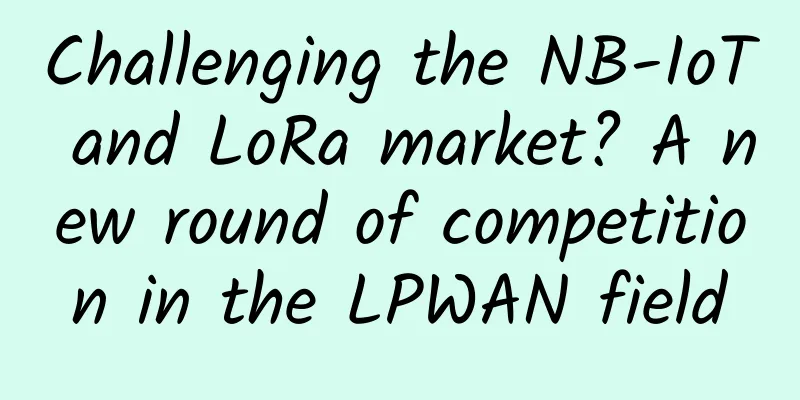Challenging the NB-IoT and LoRa market? A new round of competition in the LPWAN field

|
In recent years, the IoT industry has reached a consensus on the "60%-30%-10%" structure of IoT connections, that is, 60% of connections are achieved through low-speed networks, 30% of connections are achieved through medium-speed networks, and 10% of connections are achieved through high-speed networks. Among them, the main force of the low-speed network that accounts for 60% is the low-power wide area network (LPWAN). There is no shortage of innovators in the market. Since the industry initially recognized the value of LPWAN, various technologies have been continuously launched and commercial competition has begun. After several years of trials and tribulations, the field has now formed two mainstream communication technologies: NB-IoT and LoRa. However, new players are still entering the market, but the market environment and the positioning of various technologies have changed significantly.
In addition to NB-IoT and LoRa, new players are also expanding their territoryAccording to public information, by the end of 2020, both NB-IoT and LoRa had achieved hundreds of millions of connections. Large-scale connections have made them mainstream technologies in the LPWAN field, and have also driven the ecological prosperity and cost reduction of these two technologies. However, NB-IoT and LoRa do not completely cover all low-power, low-rate connection fields. In recent years, a number of domestic LPWAN technologies have continued to be launched for commercial use, and efforts have been made in some vertical fields. Typical representative companies that can be obtained from public information include Dao Biolink, Panqi Microelectronics, Shenglu IoT, Changzhou Qianmi Electronics, etc. Dao Biolink was founded in 2019. Its core technology is TurMass™ LPWAN communication technology. TurMass™ adopts mMIMO (massive multi-antenna) narrowband transmission technology and integrates a unique system architecture to improve LPWAN technology in terms of system capacity, rate, coverage, energy consumption, networking flexibility and comprehensive cost. Its core is a license-free mMIMO random access technology. The entire system includes terminal chips, relays, gateways, and network servers. Panchi Microelectronics mainly promotes Chirp-IoT's LPWAN technology, which improves transmission rate and network capacity and reduces the probability of interference by introducing multi-dimensional transmission modulation technology. Currently, Panchi Microelectronics has launched the Chirp-IoT-based terminal chip PAN3028 and gateway PAN3031. Shenglu IoT mainly promotes its independently developed DDA (dynamic encrypted spatial dense coverage ant colony mode). This technology is formerly known as Spider technology, which optimizes communication distance, low-cost network coverage, low-power design, anti-interference design, communication reliability, data security, massive terminal access, robustness, ease of use, and adaptive frequency band selection. Qianmi Electronics mainly promotes a wireless communication protocol called LaKi, which includes complete technical innovations of the MAC layer communication protocol and the PHY layer. It also launched the first batch of mass-produced RF SoC chips LK2400 based on LaKi at the end of March 2020. In addition to the mainstream technologies of NB-IoT and LoRa, these new LPWAN technologies are actually facing obvious survival pressure, so they must innovate in many aspects to have a place in the market. Generally speaking, the direction of these technological innovations is to make up for the shortcomings of NB-IoT and LoRa. From the public information, the new technology publicity will more or less compare the technical indicators with NB-IoT and LoRa. Judging from the technical indicators alone, they basically have certain advantages over NB-IoT and LoRa in many aspects. In addition, in terms of network deployment, these new technical solutions also adopt more flexible methods, such as basically using relays and self-organizing networks to achieve fast and flexible deployment. However, leading technical indicators does not mean leading commercial use. There are many factors that affect the final commercial use. Taking mobile communication technology as an example, mainstream technology is not the most advanced in technical indicators, but it is a technical system that all stakeholders agree on, so the industrial ecology is very complete. If non-mainstream technology systems want to gain market recognition, leading technical indicators is only a necessary condition, not a sufficient condition. Appropriate ecology and market strategies are also needed. Learning from history: The first round of LPWAN technology competitionIn 2015, low-power wide-area networks (LPWAN) began to become a hot topic in the field of the Internet of Things, and then experienced a process of letting a hundred flowers bloom and a hundred schools of thought contend. In my first monograph written in 2017, "Sniper Rifle of the Internet of Things Battlefield - Interpretation of the Low-Power Wide-Area Network Industry Market", I summarized the relevant technologies. A rough statistical analysis found that those with a spirit of technological and market innovation have launched more than a dozen low-power wide-area network technologies, forming a huge family. Each technology is eager to try, striving to make its own technology win in the competition. In general, the entire LPWAN family can be divided into two camps, and the basis for this camp division is whether the radio spectrum used by various technologies belongs to the licensed spectrum, thus forming two camps of technologies based on the licensed spectrum and technologies based on the unlicensed spectrum. Through the collection of public information, the main technologies of the two camps are shown in the following table: Main technologies of the two camps of low-power wide area networks It can be seen that although there are many companies and organizations involved in the research and development of low-power wide-area network technology around the world, the technology based on licensed spectrum is mainly promoted by the communications standardization organization 3GPP; while the unlicensed spectrum technology is completed by a large number of scattered companies and organizations, each of which owns intellectual property rights and promotes commercial use. This situation is related to the right to use the radio spectrum. It can be said that the LPWAN technology family experienced its first round of contention in 2015. After a few years, after a round of reshuffle, most technologies have faded out of people's sight, leaving only a few to open up new territories. Among them, NB-IoT and LoRa have become the undisputed mainstream technology systems, and other technology systems have finally ushered in different fates and outcomes due to strategic choices. Sigfox once had the opportunity to become the first LPWAN player, but due to its insistence on deploying public networks globally, it is facing a shortage of funds and has now had to shrink; RPMA's once bold statement of sweeping the IoT field has now been completely forgotten; even the 3GPP system's eMTC can only maintain a certain scale overseas due to the lack of support from Chinese operators. It is worth noting that ZETA, as an LPWAN technology launched in the same period of the year, has survived tenaciously when most technologies have withdrawn from the market due to its insistence on a market strategy for vertical industry applications. Although it has not become a mainstream technology, it has formed large-scale applications in vertical fields such as logistics and construction, and has also built its own industrial ecology. Different characteristics of the new round of LPWAN technology competitionAs mentioned above, in recent years, a variety of new LPWAN technologies have been launched into the market, competing for 60% of the low-speed IoT connection market. Compared with the LPWAN technology competition that emerged in 2015, this can be said to be the second round of LPWAN technology competition, and it presents different characteristics. First of all, the players in this round of LPWAN have a clear understanding of their positioning. A few years ago, when NB-IoT and LoRa had not yet formed large-scale connections, many LPWAN technologies were ambitious and believed that they had the opportunity to dominate the market and become the core IoT communication standard. A typical example is Ingenu, which launched the RPMA technology. In 2016, John Horn, then CEO of Ingenu, was full of confidence and made shocking remarks. He constantly bombarded other technologies and believed that RPMA would completely crush LoRa and Sigfox and would become the mainstream standard in the future IoT together with NB-IoT. Another typical representative is Sigfox, a "disruptor" in the IoT market. It appeared in the posture of subverting telecom operators. After several record-breaking financings, it was ultimately unable to support its ambition to become a global IoT network operator. As time goes by, most of the LPWAN technologies that still exist in the market today do not position themselves as the IoT standard that dominates the market, but are more realistically focused on a few key industry applications, and companies are more pragmatic in exploring their own value. Secondly, the LPWAN market has been verified by large-scale market, and new players have avoided many detours. In 2015, when LPWAN players started the first round of competition, there were very few connections in the low-speed IoT market at that time. This field was basically a blank market. Various application scenarios were only theoretically feasible, and there was no large-scale application verification. Manufacturers were testing the waters and believed that they could enter the corresponding market. Today, after 5-6 years of trials, the LPWAN market has seen several application scenarios with tens of millions of connections and more than 10 application scenarios with millions of connections. Various barriers and deficiencies have been fully exposed in the process of application implementation, allowing latecomers to avoid detours. In addition, the number of NB-IoT and LoRa connections exceeds 100 million, becoming the mainstream technology and de facto standard in this field. In particular, NB-IoT has formed a large-scale network infrastructure, and the quality of network coverage has been continuously improved. Its advantages in some scenarios have gradually emerged. Latecomers will also avoid direct competition with the application scenarios of these mainstream technology systems based on the analysis of advantages and disadvantages. On this basis, new LPWAN players can play to their strengths and avoid weaknesses, and focus on vertical fields where they can play to their strengths. In fact, ZETA has been able to survive in the gap between mainstream technology systems in the past few years and occupy a place in the vertical field, which is also due to its correct decisions in terms of its own positioning and market verification. In my opinion, new independent and innovative LPWAN players that have entered the market in recent years can fully learn from ZETA's experience. With the development of the Internet of Things industry, more diversified scenarios continue to emerge. One set of technical systems cannot meet the communication needs of all scenarios. Even in the LPWAN field that requires low speed, low power consumption, and long distance, many factors must be considered in the specific scenarios of each industry, making it impossible for a single LPWAN technology to cover this 60% connection field. This also gives diversified LPWAN technology systems the opportunity to survive and be commercialized. The only difference from 5-6 years ago is that the current market structure has formed a situation where NB-IoT and LoRa occupy the mainstream. This pattern may change to a certain extent in the short term, and the market share of mainstream technologies may decline due to the commercialization of other LPWAN technologies, but new entrants should not only focus on leading technical indicators, but also have a clearer understanding of the market and a more pragmatic positioning in order to occupy a place. |
<<: If you still don’t recognize the USB interface after reading this article, come and find me!
>>: 5G: Retracing the path of 4G?
Recommend
Openness, Inclusiveness, Collaborative Innovation - Network Frontier Technology Forum Held in Beijing
On October 12, 2021, during the 2021 China IPv6 I...
About edge computing: Is it right for your business?
Like most emerging IT trends, "edge computin...
The IPv6 era is coming, and every grain of sand in the world can have an IP
When it comes to IPv6, I think most people think ...
Detailed explanation of the network model splitting in the network. I finally understood it after being troubled for a long time. Take a look at it in one minute
Seven-layer model decomposition From the applicat...
Seven steps to SD-WAN deployment
The benefits of software-defined WANs are appeali...
Average tariffs to drop by another 10%. Senior management has given operators another task target! Are you ready?
At this year's two sessions, the top leadersh...
Edge cloud and 5G will impact the next era of networking
While this year has presented many challenges, we...
Wu Jiangxing, Academician of the Chinese Academy of Engineering: 6G networks must address generalized functional safety
Recently, the Future Mobile Communications Forum ...
RAKsmart server flash sale starts from $30/month, 1-10Gbps unlimited traffic server starts from $149/month, VPS 50% off
This month, RAKsmart continues the previous activ...
Ministry of Industry and Information Technology: Local governments should work harder on 5G applications
"Although various regions are now making gre...
How wireless technology will improve connectivity, efficiency and consumer experience in 2024
In 2024, wireless technology is expected to bring...
iWebFusion: US servers starting from $45/month, in Los Angeles/North Carolina/Bend/Monticello and other data centers
iWebFusion (iWFHosting) is a subsidiary of the ve...
HostYun Los Angeles, USA, CN2 GIA line AMD series VPS monthly payment starts from 16 yuan, native IP
HostYun recently launched a VPS with AMD 5950X+Sa...
In the digital age, how should enterprises achieve excellent digital experience?
[51CTO.com original article] Driven by mainstream...
Interpreting the four major reasons why my country is comprehensively promoting the implementation of IPv6!
In November 2017, the General Office of the CPC C...









